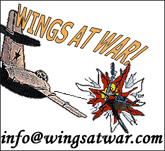Aircraft Of The Vietnam War
As has happened before in our story, the most modern of aircraft were asked to fight a war for which they were not designed; gun-less fighters conceived as long range bomber destroyers were forced to take on nimble enemy fighters at short range, nuclear bombers had to try to take out precision targets using iron bombs, and high-tech attack planes were thrown in against ancient anti-aircraft guns. The US Navy fared better as carrier aircraft have to be more flexible and able to take on a variety of roles. Navy pilots were trained to rely on old fashioned pilot skill whereas the USAF put greater faith in technology.
The North Vietnamese Air Force knew they could not compete in terms of quality or quantity so they relied on fleeting hit and run attacks by their fighters, the swift MiG-21 was well suited to the task, plus swarms of surface-to-air missilery and massed anti-aircraft artillery. Though the first of these were sometimes roughly handled by the Americans they proved too elusive to completely eliminate. The threat from the second could be alleviated to a certain degree but the third, the deadly 'Tripple-A', was far too numerous.
Though the main opposing fighters were supersonic it was rare for combat to take place at speeds faster than mach 1. Supersonic flight was avoided as it dramatically reduces a plane's manoeuverability and more importantly uses fuel at a tremendous rate - which meant that slower aircraft such as the MiG-17 could mix it with planes that had a much higher maximum speed.
By the mid-1960s it was thought that the air-to-air missile had signaled the end of the gun-armed fighter. In Vietnam it was soon discovered that this was far from the case and the early heat seeking missiles used, the US AIM-9 Sidewinder and its Soviet copy the AA-2 Atoll, had a hit ratio of one in seven at best. Various factors contributed to this failure; the missiles were originally meant to target lumbering bombers and they found it hard to keep locked on to hard turning fighters. They had to be fired from directly behind the target, the only place the seeker head could detect the heat generated by the jet engine, and a lack of discrimination meant they had a tendency to go after the sun or the heat bouncing off the ground.
The radar guided Sparrow fared even worse. Its biggest asset of long range was negated by the US rules of engagement dictating a launch only when a target was visually identified, by which time it was often well within the missile's minimum range. The Sparrow was guided to its target by the firer's nose-mounted radar so during the whole flight-time of the missile the aircraft had to keep pointing at the target. The hot and humid conditions in South East Asia played havoc with the missile's delicate electronics and malfunction rates were high. Worse still in terms of performance were the Falcon heat-seeking and radar-guided missiles used in small numbers by the F-102 and the F-4. Both the Americans and the North Vietnamese had to resort to strap on cannon pods for their main fighters.
The following lists the main aircraft that clashed over North Vietnam. The Vapour Trails catalogue number is in blue.
Mikoyan
Guryevich MiG-21
The
design was based on Soviet experience garnered during the Korean War and the MiG-21
was conceived as a simple but fast and manoeuverable pure dogfighter.
The most modern and capable of the North Vietnamese People's Army
Air Force planes, the MiG-21 came in three flavours. Due to the
marginal nature of the design, weight limitations meant that the
MiG-21F had limited fuel and could only be fitted with two 30mm
cannons. It was developed into the MiG-21PF able to carry two heat-seeking
missiles and a small nose-mounted radar, but weight considerations
meant that the cannons had to be removed. Finally, the MiG-21PFMA
was introduced, armed with four missiles and space for a 23mm twin-barrel
gun pack fitted to the plane's belly.
At first the MiG-21 was
flown with great caution by the NVPAAF pilots until a build up of
experience and confidence led to a more aggressive stance. Around
200 MiG-21s were supplied to North Vietnam. It's estimated that
eighty-five were lost (sixty-seven to USAF F-4s, two to B-52s, thirteen
to Navy F-4s and three to F-8s). The US admitted to losing nearly
sixty planes to MiG-21s. Top MiG-21 pilot was Nguyen Van Coc with
nine kills, all with heat-seeking missiles.
ISA722
Jianjiji
J-6
Chinese built copy
of the MiG-19, the first Soviet fighter capable of supersonic flight.
China supplied the North Vietnamese with a small number in 1971.
The US claimed to have shot down ten before the end of the war.
Armed with three powerful 30mm cannons and a pair of heat-seeking
missiles.
ISA712
Mikoyan-Gurevich MiG-17F
An improved MiG-15 with a sharper
swept wing and a much more powerful engine, the MiG-17 was one of
the best subsonic fighter planes. Though much slower than enemy
fighters the MiG-17's superior agility made it a tricky opponent
in a close quarter dogfight. A flight of four scored the first NVPAAF victories when they bounced four F-105s, shooting down two.
Armed with three 23mm cannons each with 80 rounds. Unable to carry missiles it was still the preferred mount of many of the
best Communist pilots. The NVPAAF received around 100 MiG-17s, the
first arriving a year before Rolling Thunder.
ISA709
McDonnell F-4 Phanton II
The most versatile and best overall
fighter of the Vietnam war was originally designed as an all-weather
fleet defence interceptor for the Navy. The role demanded a long
range, very high speed and a goodly collection of air-to-air missiles
(to reduce trips back to the carrier to reload) plus a second crewman
to take care of the advanced avionics, weapons computer and large
radar.
The result was such an outstanding plane that the USAF swallowed its pride and pressed it into service as their standard fighter. Armed with four Sparrow radar-guided missiles, intended to take out enemy bombers before they could fire anti-ship missiles at the carrier, plus four Sidewinder heat-seeking missiles for shorter range action, but no gun as the designers thought that modern missiles had obviated the need. Experience soon showed that the missiles were not up to scratch when it came to actual combat and though it was less accurate than a firmly fixed internal gun a strap-on gun pod was introduced as a stop-gap. Eventually the F-4E with internal M61 six-barrel 20mm Vulcan was introduced from 1968 but didn't see action till the Linebacker campaign where it scored half of its kills with the gun.
Including all versions of the F-4, around half of victories were by Sparrow a third by Sidewinder and the rest by gunfire. Carrier aircraft have to be multi-role so the Phantom was also able to carry a heavy bomb load of 16,000lbs, more than a World War Two American heavy bomber.
The Phantom flew every type
of mission for the USAF, US Navy and US Marines; from MiG combat
air patrol, escort, fighter-bomber, level bomber, flak suppression,
Wild Weasel and armed forward air controller, and in its RF-4 guise
as a very effective reconnaissance plane. F-4s shot down as many
enemy aircraft as all other US types combined, however 43% of US
planes shot down by MiGs were Phantoms.
ISA839 (ISA839a for F-4E)
Northrop F-5 Freedom Fighter/Tiger II
In 1965 twelve F-5s with USAF markings,
and dubbed the
Skoshi
Tigers, operated in Vietnam on an evaluation
project. Their missions included 900 sorties over North Vietnam.
The project was deemed a success and the South Vietnamese Air Force
was equipped with the (unsubtly named) Freedom Fighter and improved
Tiger II.
The F-5 was built as a lightweight cheap supersonic
fighter which America could give or sell to developing countries
friendly towards the USA. Armed with two 20mm cannons and two Sidewinder
heat-seekers, the F-5 could also carry a reasonable bomb load.
ISA841
Vought F-8 Crusader
Though not the most modern of jets the F-8 was the
principle fighter and fighter-bomber of both the Navy and the Marines
at the start of the conflict. Fast and manoeuvrable the F-8 also
had the tremendous advantage for carrier take off and landings of
a wing able to lift up at the leading edge by 7%. Armed with four
20mm cannons, four Sidewinders mounted on the fuselage sides and
in the fighter-bomber role, a decent bomb load.
F-8s shot down
twenty enemy aircraft but lost eighty-three, many to SAMs. The RF-8
shared reconnaissance duties with the far more sophisticated, and
expensive, RA-5C.
ISA840
North American F-100 Super Sabre
The 'Hun' was the West's first supersonic
fighter and a contemporary of the MiG-19. Though nearing obsolescence
it was still an excellent fighter-bomber able to take on as many
roles as the more celebrated F-4. The two-seat trainer version pioneered
the Wild Weasel mission for the USAF. Armed with Four 20mm cannons
and up to 6,000lbs of bombs.
ISA853
Convair F-102 Delta Dagger
The
Deuce was a Delta-winged radar-armed interceptor
able to carry up to six missiles, a mix of radar-homing and heat-seekers,
but no gun. Selected for the night/bad-weather airbase defence role
in South Vietnam and Thailand they saw little action over the North
and were soon replaced by the F-4.
ISA854
Lockheed F-104 Starfighter
Like the MiG-21 the F-104 was conceived
during the Korean War but came out as a completely different sort
of bird. It had the smallest wing of any fighter, which gave it
scalded-cat-like acceleration but the agility of an elephant
riding a shopping trolley. The F-104 was not in USAF service for
long and only one squadron saw limited action in Vietnam early on.
Armed with the M61 20mm Vulcan multi-barreled cannon and two Sidewinder
heat-seeking missiles.
ISA855
Republic F-105 Thunderchief
Dating from the mid 1950s the F-105
flew more missions and suffered more losses over North Vietnam, over
400 including twenty one destroyed by enemy fighters, than
any other plane. These losses represented more than half those built.
For a single-seat plane the
Thud weighed the same as the B-17 heavy bomber,
and three times that of Republic's WW2 equivalent the P-47 Thunderbolt.
Its main mission was meant to be tactical nuclear bombing and it was able to fly supersonically at sea level. Though it was fitted with a bomb bay for the nuclear bomb this was normally occupied by an extra fuel tank and iron bombs were carried on wing-mounted pylons. The internal M61 six-barreled Vulcan cannon had a 1000 rounds and the Thud normally also carried a radar-jamming ECM pod and Sidewinder heat-seeking missile. The two-seat F-105G was kited out as the USAF's principle Wild Weasel plane, carrying four anti-radar missiles and extra ECM pods.
ISA856
General Dynamics F-111
Nicknamed 'Aardvark', the F-111 suffered
a disastrous introduction to combat operations before becoming the
most effective all-weather long range penetration bomber in Vietnam.
Packed with electronic wizardry including terrain following radar
for ground hugging flight and with a variable sweep wing to taper
performance to speed and height, the F-111 was originally meant
to be a fighter-bomber, hence the F designation. It was eventually
turned into a bomber with a large internal bomb bay, but no gun,
and designed to fly completely autonomous solo missions. A detachment
designated Combat Lancer began operations in 1968 but in six weeks
half of the original six had disappeared. The cause was later found
to be a structural failure and the type was withdrawn. It returned
for Linebacker and the two squadrons, each of twelve F-111s, flew
4,030 missions out of Takhli proving it to be an amazingly elusive
(pre-stealth) and deadly accurate bomber.
ISA859
Douglas A-1 Skyraider
The ultimate piston-engined carrier
attack plane was designed during WW2 but was too late to see action. The single-seater
'Spad'
was very effective during the Korean War and in Vietnam was flown
by the Navy, Marines, USAF and South Vietnamese Air Force. Used
in many roles, one of its most celebrated guises was as an escort/flak
suppression for search and rescue helicopters with call sign
Sandy. Able to haul up to 8,000lbs of bombs on its surprisingly
agile airframe. Navy Skyraiders even managed to shoot down a
couple of MiG-17s with their four 20mm cannons.
ISA831 & ISA831b
Douglas A-3 Skywarrior
1952 saw the first flight of the largest
aircraft to be part of the regular complement of aircraft carriers.
The A-3 was meant to act as the fleet's nuclear bomber with a crew
of three and two tail mounted remotely fired 20mm cannons
for self-defence. The cannons were removed in the many special derivatives
of the Skywarrior, and though the standard A-3 with conventional
bombs only saw service in Vietnam at the beginning its reconnaissance,
ECM and tanker conversions operated throughout the war.
ISA835
Douglas A-4 Skyhawk
One of the legendary Douglas designer Ed Heinemann's
greatest aircraft, the 'Scooter' single-seater attack plane was so small
it could dispense with folding wings for carrier stowage. Nearly
3,000 were built and the A-4 saw action with the Navy and
Marines from the start. Most were armed with two 20mm cannons. Some
operated as early Wild Weasels and it was the main mount of Marine
forward air controllers.
ISA836 & ISA836a
Grumman A-6 Intruder
The aptly named Intruder was the Navy's
subsonic equivalent of the F-111, able to fly solo all-weather precision
bombing missions. The 'Iron
Tadpole' operated from carriers
and by the Marines from land bases, and though it experienced
problems with its state-of-the-art electronics, was able to take
on (and survive) missions that would have proved impossible to any
other Navy aircraft. The KA-6D was a tanker version. The EA-6A 'Sky Pig' was an ECM plane introduced by the Marines. The Navy
used the EA-6B Prowler, a much more advanced electronic warfare
platform which added a crew of four ECM Officers in an enlarged
cabin behind the cockpit
ISA873
Vought A-7 Corsair II
Though intended for the same role
as the Skyhawk and similarly single-seat, subsonic and armed with two 20mm
cannons; the A-7 was a vastly more capable machine, particularly
in terms of electronics, range and bomb load. The 'SLUF' (Short
Little Ugly Fella in the bowdlerised version) first saw action over
the North in 1967 with the Navy and Marines and was also the main
Navy SAM buster. Like the Phantom, the Air Force also produced their
own version of the A-7 though this only reached Vietnam in the
last few months of the war.
ISA837
Boeing B-52 Stratofortress
America's eight engine monster of a strategic nuclear bomber operated in the main out of the island of Guam during the war and managed to plaster Vietnam and its neighbours with three times the weight of bombs dropped during the whole of World War Two. At first they were not used against North Vietnam but operated against the Viet Cong in the South. The value of hitting large areas of jungle, which may or may not have contained enemy guerillas, may be questioned but for Linebackers I and II they were finally unleashed upon the North's industrial and transport infrastructure with devastating results.
For defence the 'BUFFS' or Big Ugly Fat Fellas (cf. above) were armed with a host of electronic countermeasures gear, which worked best when B-52 formations combined their efforts, and four radar directed tail mounted 0.5" machineguns. Two MiG-21s were shot down by B-52s. Twenty nine were lost during the war.
ISA852
Martin B-57 Canberra
The B-57 was an improved Canberra
but with a tandem-seat cockpit rather than side-by-side as in the
original. The USAF had cast around for a tactical bomber in the
mid-1950s and discovered that the British Canberra was by far the
best candidate. Unlike the British plane it was fitted with four
fixed 20mm cannons. The B-57's long endurance, multifarious weapon
hard points (including an internal bomb bay) and great manoeuverability
made it ideal for the forward air controller mission.
ECM and reconnaissance (RB-57) versions also gave outstanding service in the early part of the war.
Eight Australian Canberras, based on the British gun-less B.2 model and without the American wing hard points were sent to Vietnam in 1967 and proved to be extremely accurate bombers, targeting Viet Cong guerrillas. The B-57s left Vietnam at the end of 1967.
ISA846 (ISA608 for RAAF)
North American OV-10 Bronco
A joint USAF and Marine project for
the forward air controller (FAC) role. The twin-propeller Bronco
was nippy and could be armed with two 7.62mm machine guns plus up
to 3,600lbs of bombs or cannon pods. Marine FACs were camouflaged
dark olive, USAF light grey.
ISA845
North American RA-5C Vigilante
The RA-5C started life as a very big
supersonic carrier attack bomber. The bomber version was not in
service for long but its reconnaissance derivate was the most advanced
tactical reconnaissance plane in Vietnam. Over 100 unarmed RA-5Cs
were built.
ISA838
McDonnell RF-101 Voodoo
The original F-101 was designed as
a long-range escort but its role changed to nuclear armed fighter-bomber
before it entered service. Though a large plane, its small wing
helped it to be fast. However, the small wing also meant it was
not much good at going round corners. The F-101 did not go to Vietnam
but the RF-101 version was the main USAF reconnaissance plane until
the introduction of the photo Phantom. The mission was fraught with
danger as it demanded flying in a straight line for long periods.
The choice was fly low to avoid the SAMs and MiGs but get hit by
the anti-aircraft artillery, or avoid the AAA and get nailed by
the SAMs and enemy fighters. RF-101s could expect to suffer damage
from enemy fire on every other mission.
Grumman EC-1A
The twin engine propeller-driven EC-1A was an electronic
countermeasures version of the Tracker anti-submarine warfare plane
and flew from US carriers.
ISA832
Douglas EB-66 Destroyer
The B-66 version of the Navy's A-3
bomber was disappearing from the Air Force inventory and none saw
action in Vietnam. However, the electronic warfare version was for
many years the only dedicated USAF ECM plane in Vietnam. The EB-66
housed four tons of electronic equipment and its exterior was studded
with dozens of antennas, chaff dispensers, receivers, flares and
additional jammers. The RB-66 reconnaissance model was also widely
used.
ISA835
Douglas EF-10 Skyknight
The US Navy's first carrier jet nightfighter
dated from the end of the 1940s and was designated F3D. Soon after
the Korean War thirty five were converted to some of the first electronic
warfare jets. These were still being used by the Marines until the
end of the war in Vietnam.
ISA823
Boeing KC-135 Stratotanker
Developed from the Boeing 707 passenger
airliner. Eventually a fleet of several hundred KC-135 aerial
refueling
tankers plied their trade over the skies of Vietnam and neighbouring
Thailand. Over 31,000 US gallons of fuel, enough to fill a whole
squadron of Phantoms, could be pumped out at 1,000 gallons per minute.
Use ISA851
Search And Rescue Helicopters
The Vietnam War could be described
as the first helicopter war; by its end the US Army's inventory
of helicopters made it the world's third largest air force. One of the main, and
most dangerous, helicopter missions was the rescue of downed aircrew.
The ubiquitous UH-1 Iroquois 'Huey' (from the original HU-1 designation)
was used by all three services but more important were the larger
and more capable helicopters introduced during the course of the
war. Based on the Navy's H-3 Sea King, the HH-3 Jolly Green Giant
used by the USAF was armoured and had facilities for in-flight refueling
enabling it to reach anywhere in South East Asia. The Marines used
their enormous assault helicopter the 38-passenger CH-53 Sea Stallion.
The Air Force eventually replace their Jolly Green Giants in the
SAR mission with their own version of the powerful CH-53 designated
the HH-53 Super Jolly. This was first used in 1968 and had extra
armour, improved avionics, 7.62mm Miniguns, and even ejection seats
for the pilots! The Navy employed the H-2 Seasprite and the original
SH-3 Sea King with its 250 foot cable winch.
US helicopter designations
can be slightly confusing, with different designations for Air Force,
Navy and Marines plus Sikorsky 'S' series numbers. The Sea King
for instance has a veritable alphabet soup of titles; S-61, H-3,
HH-3, CH-3, SH-3 and HSS-3.
ISA865 for the UH-1 & ISA819 for the Sea King
The SAM Threat
In 1960 a single S-75 Dvina surface-to-air missile (SAM) shot down Gary Powers in his U-2 spyplane over Russia. Designated SA-2 Guideline in NATO parlance, this 'telephone pole' sized missile was guided to its target by a Fan Song radar mounted on a big trailer. In Vietnam a SAM battery usually consisted of six launchers connected to a single search radar which acquired the targets before passing them on to each missile's own Fan Song. Though nominally mobile it took several hours to set up the missiles and vehicles in their distinctive star-shaped emplacements. Batteries tended to move overnight to a different position in order to make it as difficult as possible for the Americans.
The Vietnamese eventually used thousands of SA-2s against US planes and although continuous improvements in American counter measures reduced their effectiveness - hit rate went down from over 5% to less than 2% - they were always a threat that could not be ignored. At times they seemed almost to have exerted a psychological grip on some US crew. In 1967 SAM sites were afforded top priority as targets for US planes; any SAM detected had to be attacked no matter what the aircraft's assigned target. With a range of up to 50km and maximum speed of more than three times the speed of sound, the SAM was lethal if it's proximity fuse triggered the warhead when within 60m of an aircraft. Electronic jamming or, if the missile was spotted, hard jinking (the 'Funky Chicken' in the vernacular of the times) or diving directly at the oncoming missile were effective countermeasures.
Attack is often the best form of defence and the Americans devised the Wild Weasel plane to take on the SAMs. Wild Weasel planes (Iron Hand in Navy parlance) were normally two-seaters or converted from two-seat trainer versions of single-seaters. They were equipped with as much electronic countermeasures gadgetry as could be accommodated and two to four anti-radar missiles (ARM), usually AGM-45 Shrikes as the more effective but much more expensive AGM-78 Standard ARM was only sanctioned if a kill was more or less guaranteed. The ARM worked by locking on and then homing in on the SAM's Fan Song radar whose destruction rendered the missiles impotent.
The SA-2 was longer ranged and faster than a Shrike so the Wild Weasel had to approach to well within the SAM's range. The faster SAM could try and take out the attacker before a Shrike was launched, or switch off its radar, thus causing both ARM and SAM to lose their guidance and miss, or could indulge in a deadly game of 'chicken'. ARMs would often be lobbed, more-or-less at random, in the hope of inducing the battery's radar operators to switch off. However, some Wild Weasel crew pursued the more aggressive 'down the throat' attack at short range and low level in an effort to take-out the threat. More SAM batteries were destroyed by this method but Wild Weasel losses were correspondingly higher.
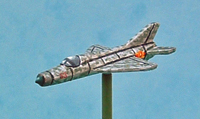
MiG-21
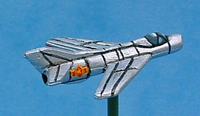
J-6 (MiG-19)
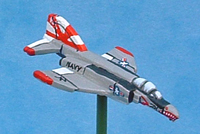
F-4 Phantom II
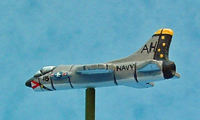
F-8 Crusader
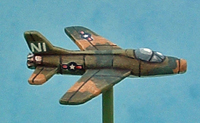
F-100 Super Sabre'
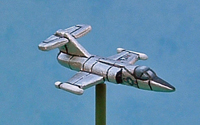
F-104 Starfighter
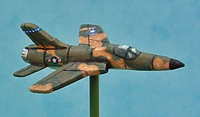
F-105 Thunderchief
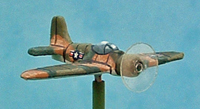
A-1 Skyraider
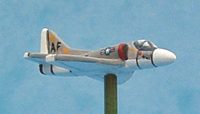
A-4 Skyhawk
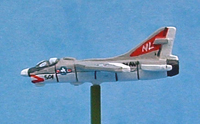
A-7 Corsair II
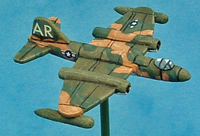
B-57 Canberra
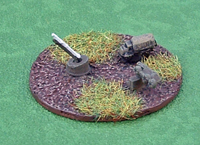
scratch-built SA-2 SAM
Click on the links below for more information
